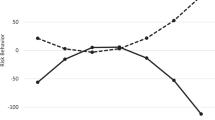Abstract
Examined the validity of adolescents' reports of their mother's age. Most research on the validity of self-report focuses on personal behaviors such as alcohol and substance use, or response bias due to social desirability. Few studies investigate the validity of adolescents reporting of nonsensitive information. Data from 80 mother–adolescent pairs were collected. The sample included 9th graders from four high school English classes, equal numbers of males and females, and 15% African Americans. The correlation between mothers' reports and youths' reports of mother's age was .99, and 95% of the youth were within a year of their mother's correct age. No race or gender differences were found. These results allow researchers to examine adolescent outcomes for youth born to teen mothers without the expense of also collecting data from their mothers. Results also suggest that adolescents' self-reports of other nonsensitive familial data may also be valid.
Similar content being viewed by others
REFERENCES
Bauman, K. E., & Ennett, S. E. (1994). Tobacco use by black and white adolescents: The validity of self-reports. American Journal of Public Health, 84, 394–398.
Campanelli, P. C., Dielman, T. E., & Shope, J. T. (1987). Validity of adolescents' self reports of alcohol use and misuse using a bogus pipeline procedure. Adolescence, 22, 7–22.
Crockett, L. J., Schulenberg, J. E., & Petersen, A. C. (1987). Congruence between objective and self-report data in a sample of young adolescents. Journal of Adolescent Research, 2, 383–392.
Davis, H., & Gergen, P. J. (1994). The weights and heights of Mexican-American adolescents: The accuracy of self-reports. American Journal of Public Health, 84, 459–462.
Dubow, E. F., & Luster, T. (1990). Adjustment of children born to teenage mothers: The contribution of risk and protective factors. Journal of Marriage and the Family, 52, 393–404.
East, P. L., & Felice, M. E. (1990). Outcomes and parent-child relationships of former adolescent mothers and their 12-year-old children. Developmental and Behavioral Pediatrics, 11, 175–183.
Furstenberg, F. F., Brooks-Gunn, J., & Morgan, S. P. (1987). Adolescent mothers and their children in later life. Family Planning Perspectives, 19, 142–151.
Geronimus, A. T., Korenman, S., & Hillemeier, M. M. (1994). Does young maternal age adversely affect child development? Evidence from cousin comparisons in the United States. Population and Development Review, 20, 585–609.
Ketterlinus, R. D., Henderson, S., & Lamb, M. E. (1991). The effects of maternal age-at-birth on children's cognitive development. Journal of Research on Adolescence, 1, 173–188.
Author information
Authors and Affiliations
Rights and permissions
About this article
Cite this article
Zimmerman, M.A., Rowe, K., Tuttle, L. et al. Validity of Adolescents' Report of Maternal Age. Am J Community Psychol 25, 887–891 (1997). https://doi.org/10.1023/A:1022221430914
Issue Date:
DOI: https://doi.org/10.1023/A:1022221430914




